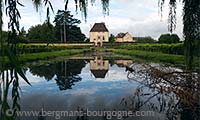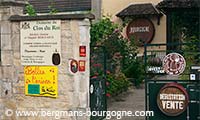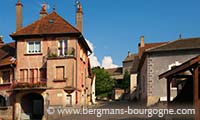
n Roman mythology Mercury was the god of trade, profit and commerce and he has lent his name to this wine-producing village 13 kilometres northwest of Chalon-sur-Saône. With well over 600 hectares of vines Mercurey is the largest vignoble along the Côte Chalonnaise and the second largest village appellation in Burgundy. Chablis has 878 hectares, Meursault 454 hectares and Beaune 449 hectares. Mercurey is mainly a red appellation, but there is a small amount of Mercurey Blanc made from chardonnay both on village and premier cru level. Pinot noir accounts for close to 90 percent of the production.
– Since it is such a large appellation you get different styles, explains Laurent Juillot at Domaine Michel Juillot in Mercurey. But you always have this fruitiness when the wine is young and you always have the richness of the tannins. For me four or five years is the best age to drink a red Mercurey. And when you have a big vintage like 1985, 2005 or 2009 you can keep it longer.
The appellation Mercurey dates back to 1923. The appellation stretches across the two communes of Mercurey and Saint-Martin-sous-Montaigu, with the major part in the former. In the 1940's premier crus were added to the village portfolio. Today there are 32 climats classed as premier cru, in both colours.

– White Mercurey represents less than 15 per cent of the surface area in the village, says Laurent Juillot. But white Mercurey is becoming more and more well known. We have a beautiful terroir for the white. Much of the soil is marnes and this adds minerality to the wine. The minerality is one of the characteristics of a white Mercurey. When the wine is young this minerality supports the fruit and makes the wine very nice to drink. Thanks to the minerality this is also a nice wine to keep. The way it develops is very interesting. Over time it adds notes of leaves, mushrooms and petrol.
In his book on Mercurey Paul Jeannin-Naltet tells us that after World War II there were hopes that the market for white Mercurey would increase. The American soldiers had taken a liking to this wine. Several winegrowers chose to replant for white, but unfortunately demand soon dropped and in 1982 the Mercurey blanc only accounted for 5.1 per cent of the annual production.
Mercurey holds quite a few monopoles, vineyards with a single owner. There are eight premier cru monopoles and six village. The Nuits-Saint-Georges-based Domaine Faiveley owns five of these – the premier cru Clos des Myglands and the village lieux-dits Framboisières, Clos Rond, Les Mauvarennes and Clos Rochette. It was Guy Faiveley, the grandfather of today's president Erwan Faiveley, which in 1964 decided to expand the holdings into the Côte Chalonnaise. The purchase included 60 hectares, mainly in Mercurey, and more than doubled the size of the estate in one single stroke.
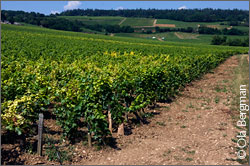
– His thoughts were pretty simple, explains Erwan Faiveley. Already back then the wines from the Côte de Nuits and the Côte de Beaune were expensive. As a result, to have some good-value-for-money Burgundies, you had to go to the Côte Chalonnaise. I guess that's the main reason why he bought that domaine.
– The wines from the Côte Chalonnaise are more of everyday wines, continues Erwan Faiveley. Even though a Mercurey or a Rully is considered to be quite an expensive wine in most restaurants those wines are everyday wines. In our case most of the Côte de Nuits and the Côte de Beaune is exported, while most of the Côte Chalonnaise is consumed in France.
Domaine du Meix Foulot in Touches is the owner of the Clos du Chateau de Montaigu, a 1.90 hectare premier cru monopole right next to Les Vellées.
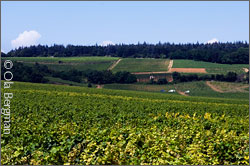 – The exposure is northeast, at the top of a smooth hill, explains Agnès Dewé de Launay at Domaine du Meix Foulot. It is like a cat sleeping in the sun, not a hot one but under a soft light sun. There is no shadow late in the afternoon. The soil is very complex; at the top you have white clay with a high level of limestone – which gives the structure – and at the bottom you have a light brown soil with stones – which gives the fruit and the finesse. I call this premier cru my Clos de Vougeot; this grand cru was exceptional when all the parts were vinified all together. The top balances the bottom and the left side complements the right side. This complexity makes the terroir.
– The exposure is northeast, at the top of a smooth hill, explains Agnès Dewé de Launay at Domaine du Meix Foulot. It is like a cat sleeping in the sun, not a hot one but under a soft light sun. There is no shadow late in the afternoon. The soil is very complex; at the top you have white clay with a high level of limestone – which gives the structure – and at the bottom you have a light brown soil with stones – which gives the fruit and the finesse. I call this premier cru my Clos de Vougeot; this grand cru was exceptional when all the parts were vinified all together. The top balances the bottom and the left side complements the right side. This complexity makes the terroir.
– This cuvée always needs two years after bottling before it begins to reveal all its richness; before you only have 70 per cent of its potential. The attack is elegant with flavours of red fruits (raspberry, cherry) and a bit of spices depending on the vintage (pepper, cinnamon). You have a velvety structure and finally an enormous length in your mouth. The more you wait – cellar it up to ten to twelve years – the more you will enjoy the wine.
 In 577 Mercurey was called Mercureis, mentioned in the foundation charter for the monastery Saint-Marcel de Chalon-sur-Saône. Mercuriacum is found in 885, Mercoriacus in 942 and Mercuriacus during the 11th century.
In 577 Mercurey was called Mercureis, mentioned in the foundation charter for the monastery Saint-Marcel de Chalon-sur-Saône. Mercuriacum is found in 885, Mercoriacus in 942 and Mercuriacus during the 11th century.
In Roman times Mercurey had a favourable position between Chalon-sur-Saône and Autun along the Via Agrippa, one of the strategic routes in ancient Gaul. There is said to have been a temple dedicated to Mercury here, but there are no traces left today.
Today's Mercurey was originally two communes – Touches and Mercurey, one on each side of the valley. Touches, with its 13th century church, is located just above La Pillotte and the premier crus of La Bondue and En Sazenay. On the opposite side is Mercurey, surrounded by premier crus such as Les Combins, Les Champs Martins, Le Clos des Barraults and Clos Tonnerre.
During the 19th century the commune of Touches expanded down by the Chalon-Autun road that was once part of Via Agrippa, today's high street in Mercurey. With 200 vehicles per day passing through there was a need for more commerce in connection with road a new hamlet was formed here. This would become known as Bourgneuf and as time went by the hamlet became the central part of the commune, so in 1897 the local authorities decided to change the name of the commune to Bourgneuf-Val d'Or.
At that time discussions about merging the two communes had been going on for some time. They were both producing wine under the Mercurey appellation, but it took a long time before they were ready to go ahead. There were discussions on and off during close to two centuries, but in 1971 the two communes finally united under the name of Mercurey..
© 2013 Ola Bergman










